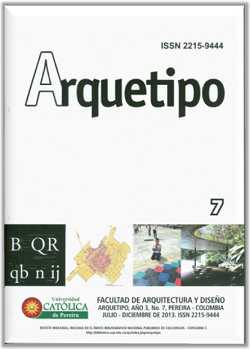Eco-envolventes valoradas desde un análisis de ciclo de vida del producto
Palabras clave:
Ciclo de Vida, confort térmico, ventajas competitivasResumen
El artículo presenta el desarrollo de un módulo para identificar su confort térmico luego de colocar una eco-envolvente. Asimismo, se buscó que la construcción de dicho módulo correspondiera con criterios ambientales, por lo que se escogió el Análisis de Ciclo de Vida (ACV) para determinar la mejor opción. Se planteó una metodología que implicó el uso de dos herramientas para el desarrollo del análisis, con el propósito de dar mayor robustez a los resultados. La propuesta se fundamentó en lineamientos de la visión de la firma basada en recursos naturales. Se proyecta que las soluciones que puedan definirse con apoyo en dicho análisis se enmarquen en una dimensión estratégica ambiental.
Referencias
Barney, J. (1991). Firm Resources and Sustained Competitive Advantage. Journal of Management, 17(1), 99.
Boks, C. (2006). The soft side of ecodesign. Journal of Cleaner Production, 14(15– 16), 1346-1356. doi: 10.1016/j.jclepro.2005.11.015
De Bakker, F. G. A., Fisscher, O. A. M. & Brack, A. J. P. (2002). Organizing productoriented environmental management from a firm’s perspective. Journal of Cleaner Production, 10(5), 455-464. doi: 10.1016/s0959-6526(02)00012-4
De Lange, D. E., Busch, T. & Delgado-Ceballos, J. (2012). Sustaining Sustainability in Organizations. Journal of Business Ethics, 110(2), 151-156.
Estrela, S. (2011). Life Cycle Thinking in Canada. Journal of Industrial Ecology, 15(4), 479-482. doi: 10.1111/j.1530-9290.2011.00363.x
Fowler, S. J. & Hope, C. (2007). Incorporating sustainable business practices into company strategy. Business Strategy & the Environment (John Wiley & Sons, Inc), 16(1), 26-38. doi: 10.1002/bse.462
Hart, S. L. (1995). A Natural-Resource-Based View of the Firm. The Academy of Management Review, 20(4), 986-1014.
Hart, S. L. (1997). Beyond Greening: Strategies for a Sustainable World. Harvard Business Review, 75(1), 66-76.
Hart, S. L., & Dowell, G. (2011). Invited Editorial: A Natural-Resource-Based View of the Firm: Fifteen Years After, Editorial, Journal of Management, pp. 1464- 1479. Retrieved from http://search.ebscohost.com/login.aspx?direct=true&d b=bth&AN=65152028〈=es&site=ehost-live
Heiskanen, E. (2002). The institutional logic of life cycle thinking. Journal of Cleaner Production, 10(5), 427-437. doi: 10.1016/s0959-6526(02)00014-8
Hossaini, N. & Hewage, K. (2012). Sustainable Materials Selection for Canadian Construction Industry: An Emergy-Based Life-Cycle Analysis (Em-LCA) of Conventional and LEED Suggested Construction Materials. Journal of Sustainable Development, 5(1), 2-12.
ISO. (2007a). NTC-ISO 14040. Gestión Ambiental. Análisis de Ciclo de Vida. Principios y Marco de Referencia (pp. 24). Bogotá: ICONTEC.
ISO. (2007b). NTC-ISO 14044. Gestión Ambiental. Análisis de Ciclo de Vida. Requisistos y Directrices. Requisitos del Ciclo de Vida. (pp. 50): ICONTEC.
Lewandowska, A. (2011). Environmental life cycle assessment as a tool for identification and assessment of environmental aspects in environmental management systems (EMS) part 1: methodology. The International Journal of Life Cycle Assessment, 16(2), 178-186.
Lin, H. (2012). Cross-sector Alliances for Corporate Social Responsibility Partner Heterogeneity Moderates Environmental Strategy Outcomes. Journal of Business Ethics, 110(2), 219-229. doi: http://dx.doi.org/10.1007/s10551-012- 1423-2
Poudelet, V., Chayer, J., Margni, M., Pellerin, R. & Samson, R. (2012). A processbased approach to operationalize life cycle assessment through the development of an eco-design decision-support system. Journal of Cleaner Production, 33(0), 192-201. doi: 10.1016/j.jclepro.2012.04.005
Sharma, S. & Vredenburg, H. (1998). Proactive Corporate Environmental Strategy and the Development of Competitively Valuable Organizational Capabilities. Strategic Management Journal, 19(8), 729-753.
Suh, S. & Huppes, G. (2005). Methods for Life Cycle Inventory of a product. Journal of Cleaner Production, 13(7), 687-697. doi: 10.1016/j.jclepro.2003.04.001
Van Berkel, R., Van Kampen, M. & Kortman, J. (1999). Opportunities and constraints for Product-oriented Environmental Management Systems (P-EMS). Journal of Cleaner Production, 7(6), 447-455. doi: 10.1016/s0959-6526(99)00232-2
Von Bahr, B. & Steen, B. (2004). Reducing epistemological uncertainty in life cycle inventory. Journal of Cleaner Production, 12(4), 369-388. doi: 10.1016/ s0959-6526(02)00197-x
Wernerfelt, B. (1984). A Resource-Based View of the Firm. Strategic Management Journal, 5(2), 171-180.
Yin, R. K. (2009). Case Study Research. Design and Methods (Fourth Edition ed.): Sage Publications inc., USA.

